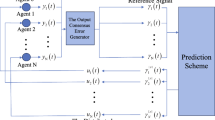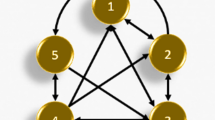Abstract
This paper proposes a distributed model predictive control method for a consensus of robotic swarm systems. The proposed method is free from any precomputed trajectories, contrast to previous studies. This is huge advantages in cases the system do not work as previously predicted, communication topology changes frequently, and the communication is unreliable. I introduce a concept of local subsystem regulator first, and then the distributed control method and its design concept are described. I also analyze stability of the proposed method and introduce how to handle constraints such as a mutual collision avoidance into the proposed method. Computer simulations are demonstrated to show effectivity of our method.



Similar content being viewed by others
Explore related subjects
Discover the latest articles, news and stories from top researchers in related subjects.References
Olfati-Saber R, Fax JA, Murray RM (2007) Consensus and cooperation in networked multi-agent systems. Proc IEEE 95(1):215–233
Fukushima H, Kon K, Matsuno F (2005), Distributed model predictive control for multi-vehicle formation with collision avoidance constraints. In: Proceedings of IEEE Conference on Decision Control, pp 5480–5485
Dunbar WB, Murray RM (2006) Distributed receding horizon control for multi-vehicle formation stabilization. Automatica 42(4):549–558
Keviczky T, Borrelli F, Fregene K et al (2008) Decentralized receding horizon control and coordination of autonomous vehicle formations. IEEE Trans Control Syst Tech 16(1):19–33
Kuriki Y, Namerikawa T (2015) Formation control with collision avoidance for a multi-UAV system using decentralized MPC and consensus-based control. SICE J Control Meas Syst Integr 8(4):285–294
van den Berg J, Guy SJ, Lin M, Manocha D (2008) Reciprocal velocity obstacles for real-time multi-agent navigation. In: Proceedings of IEEE conference on robotics and automation, pp 1928–1935
Murayama T (2016) Distributed velocity constraints for multi-agent system to preserve communication range. In: Proceedings on 2016 IEEE/SICE international symposium on system integration, pp 532–537
Mattingley J, Boyd S (2012) CVXGEN: a code generator for embedded convex optimization. Optim Eng 13(1):1–27
Chung F (1997) Spectral graph theory. American mathematical society, Providence
Mayne DQ, Rawlings JB, Rao CV, Scokaert POM (2000) Constrained model predictive control: stability and optimality. Automatica 36:789–814
Grimm G, Messina MJ, Tuna SE, Teel AR (2005) Model predictive control: for want of a local control Lyapunov function, all is not lost. IEEE Trans Autom 50(5):546–558
Author information
Authors and Affiliations
Corresponding author
A Proof of Theorem 1
A Proof of Theorem 1
The whole system can be written as
where \({\mathcal {L}}_{\mathrm {rw}}\) denotes a random-walk normalized Laplacian matrix defined as \({\mathcal {L}}_{\mathrm {rw}}={\mathcal {D}}^{-1}{\mathcal {L}}\). Using a linear transformation \(\xi = (X^{-1}\otimes I_{n_{s}})x\) and \(\eta = (X^{-1}\otimes I_{n_{r}})\varepsilon\) with the matrix X diagonalizing \({\mathcal {L}}_{\mathrm {rw}}\) such that \(\Lambda =X^{-1}{\mathcal {L}}_{\mathrm {rw}}X\), we get
with \(\Lambda = {\mathrm {diag}}(\lambda _{1,{\mathrm {rw}}},\ldots ,\lambda _{N,{\mathrm {rw}}})\). Here \(\xi \triangleq (\xi _{1},\ldots ,\xi _{N})^{\mathrm {T}}\) indicates \(\xi _{1}=\sum _{i}x_{i}/\sqrt{N}\) is average (or sum) of the agents states \(x_{i}\) and the others \(\xi _{i},i\ge 2\) are orthogonal to \(\xi _{1}\). Therefore, if \(\xi _{i},^{\forall }i\ge 2\) converge to zero, then the state x converges to the consensus manifold \({\mathcal {M}}\).
Applying the same translation to the assumption Eq. (18) as
we get
since \(\lambda _{1,{\mathrm {rw}}} =0\). Then, the norm of the translated states satisfies
because \(\lambda _{i,{\mathrm {rw}}}\in (0,2],^{\forall }i\ge 2\) (this is easily derived from eigenvalues of a symmetric normalized Laplacian \({\mathcal {L}}_{\mathrm {sym}}={\mathcal {D}}^{-1/2}{\mathcal {L}}{\mathcal {D}}^{-1/2}\), see [9]). This fact suggests the states \(\xi _{i}\) orthogonal to the consensus manifold \({\mathcal {M}}\) converge to 0, thus we conclude x(t) converges to \({\mathcal {M}}\) as \(t\rightarrow 0\). \(\square\)
About this article
Cite this article
Murayama, T. Distributed model predictive consensus control for robotic swarm system. Artif Life Robotics 23, 628–635 (2018). https://doi.org/10.1007/s10015-018-0499-x
Received:
Accepted:
Published:
Issue Date:
DOI: https://doi.org/10.1007/s10015-018-0499-x




